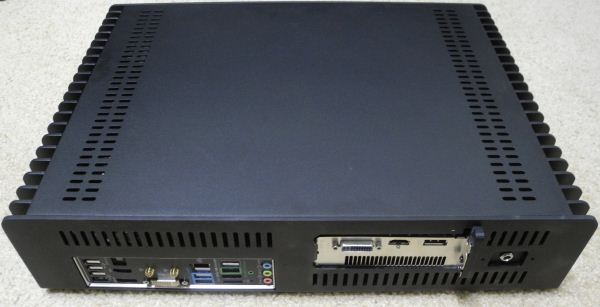Streacom's FC10 and Nano150: Building a Fanless Ivy Bridge HTPC
by Ganesh T S on December 22, 2012 3:30 AM EST- Posted in
- HTPC
- Fanless
- Ivy Bridge
Concluding Remarks
Building a passive system might be more challenging compared to assembling an actively cooled one. However, the satisfaction of seeing a PC up and running without making even the slightest noise has to be experienced to be appreciated. The assembly of the Streacom FC10 was made more challenging than necessary, thanks to the faulty user guides uploaded initially. However, Streacom has fixed the problem now, and they have also posted a system builders guide for customers of their fanless cases. If one were to nitpick, it would be the PCIe slot spacing (which may leave some users with no option but to do a case mod) and the fact that only pico-PSUs are supported. The chassis could have been designed to accommodate a full-sized PSU (some excellent relatively high power fanless options are available from Seasonic) given that the current version is sized to even accept ATX motherboards.
We have used the Streacom FC10 chassis and the Nano150 PSU to successfully build a completely silent HTPC. In the next part of the three-part series, we will look at the performance of the PC for general workloads (synthetic benchmarks) and also its suitability for HTPC purposes (including decoding and rendering benchmarks as well as network streaming performance).
Thank You!
Thanks to Streacom, Perfect Home Theater, Asus, G.Skill and Intel for providing us with the testbed components for our three-part HTPC series.











63 Comments
View All Comments
colonelciller - Sunday, December 23, 2012 - link
Does the i3-3225 support 23.976 playback?Aikouka - Sunday, December 23, 2012 - link
Last I recall, Intel's drivers do have a "24 FPS" setting, but it is not true 23.976. However, my information may be out of date!casteve - Saturday, December 22, 2012 - link
Thanks for the review, but what are the units of time in the graphs? seconds, minutes, mayan long count?ganeshts - Saturday, December 22, 2012 - link
Apologize for the oversight. The time unit is in (s). The first graph is not very clear (I had actually let our power logger script run for 100 minutes = 6000s). For the loading temperature graphs, I had indicated in the text that the burn-in testing was run for 12 hours (=43200s).kyuu - Saturday, December 22, 2012 - link
First paragraph on page 3:"There was a toss up between building a Trinity-based testbed and a Ivy Bridge-based testbed. In the end, the fact that Trinity emerged as being a capable madVR candidate (with software based decoding), and the fact that madVR recently introduced DXVA scaling (an upside for Intel since its offerings weren't fully madVR capable earlier, and something that we wanted to test out) persuaded us to go for an Intel-based testbed."
Am I missing something or is this messed up? You describe (what I assume are) positive aspects of Trinity, then use that as the justification for using Ivy Bridge? Huh?
ElvenLemming - Saturday, December 22, 2012 - link
The way I interpreted that was that because the madVR support is newer and less-tested for Intel, they decided to go with an Intel build here so they could use the same machine for future madVR testing.The paragraph wasn't worded very clearly, but that's what I got out of it.
ganeshts - Saturday, December 22, 2012 - link
Yes, I could have conveyed that in a better manner, but ElvenLemming's interpretation is right. In our Trinity and Ivy Bridge reviews, we found that 720p60 H.264 streams gave trouble to HD 4000. Recently, madVR introducied DXVA scaling, and I have it from very reliable sources that Mathias (madVR developer) is working closely with Intel. So, we wanted to have the right platform to evaluate these developments.kyuu - Sunday, December 23, 2012 - link
Ah got it. Thanks for the clarification.Schafdog - Saturday, December 22, 2012 - link
What's the idle power of the system?ganeshts - Saturday, December 22, 2012 - link
That is coming in Part 2 of the review :) As a sneak peek, I can say it is around 28 W. Power measurement during Blu-ray playback and other workloads will be dealt with in detail in the next series installment.